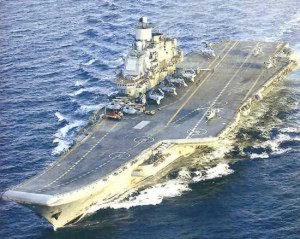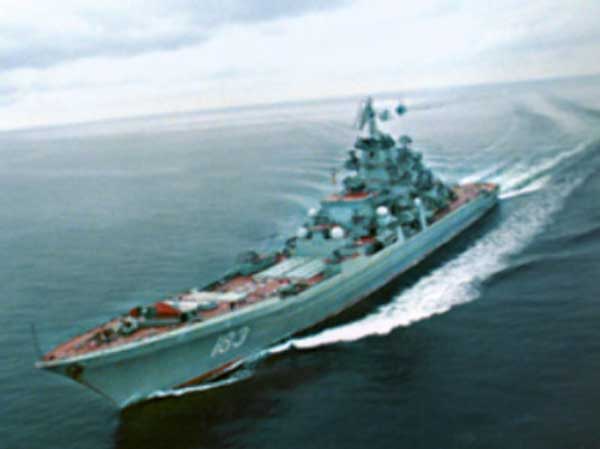11/06/2011 – by Richard Weitz
The Russian media is now reporting that the Russian Navy leadership has recommended building two aircraft carrier battle groups by 2027.
One would serve in the Northern Fleet (for deployment primarily in the Atlantic Ocean) and one with the Pacific Fleet. Navy leaders considered but rejected the argument that Russia could perhaps get by with a mixture of advanced surface and submarine ships alone.
Instead, they endorsed the so-called “American model” of having a carrier task force, which in addition to the carrier itself would include about 15 auxiliary escort ships such as cruisers, destroyers, frigates, corvettes, landing craft, multi-purpose submarines, and icebreakers for deployment on Arctic cruises.
The Navy is now finalizing the technical requirements for the new carrier, though it has already been decided that the ship will be nuclear powered. The Navy will then examine competing designs for the next carrier and make a decision on that issue by 2017. The goal would be to launch the first carrier by 2023.
The Navy also plans to build new maintenance facilities for the carriers that hopefully will avoid the problem that plagued the Soviet carrier fleet, which was not adequately sheltered from the elements, as well as a simulator for landing planes on a carrier at Yeisk in the Krasnodar region. This new Yeisk facility would supplement the Nitka Naval Pilot Training Center in the Crimea, which Russia rents from Ukraine and has offered to upgrade.
Russian President Dmitry Medvedev and Prime Minister Vladimir Putin are now considering the Navy chiefs’ recommendation. It should be recalled that Russian leaders have made such a recommendation many times before, including quite recently, but then a lack of money and other barriers derailed these visions. In July 2008, the commander-in-chief of the Russian Navy, Admiral Vladimir Vysotsky, stated that the Navy intended to form five or six aircraft carrier task forces, to be deployed with the Northern and Pacific fleets. Later that year, President Medvedev also has said that Russia intended to build aircraft carriers as part of its general naval rearmament program. But the Russian Navy then had to back track and later announce that Russian would not have a new carrier for at least another decade.
The most important indicator that Russia has again become a global sea power would be if the Russian government acquired a genuine aircraft carrier fleet. The 2011-2020 Russian State Armament Program (SAP, or Gosudarstvennaya Programma Vooruzheniya, GPV, in Russian) commits to funding the repair and upgrading of Russia’s single Project 11435 Admiral Kuznetsov ship. Even the Russian Navy terms this vessel a “heavy aircraft carrying cruiser” rather than a real aircraft carrier because its air component has limited functionality. In the past, the ship has had as few as eight Su-33 aircraft. These can combat other planes and attack surface ships and submarines, but the small number of planes leaves them vulnerable to counterattack. In addition, the Kuznetsov uses diesel-electric power, which limits its time at sea.

The Kuznetsov has seen little action. It has repeatedly gone out-of-service since joining the Northern Fleet in January 1991. The ship has undergone at least three major repairs during the past six years.
Since the Kuznetsov was constructed in the late 1980s, it could remain operational until the 2030s if continuously modernized and maintained. According to some experts, the planned upgrades under the latest SAP are so extensive—a new propulsion system as well as new aircraft, armaments, and electronics—that they might produce an entirely new and improved ship. For example, the ship could be capable of carrying a mixture of as many as 26 Su-33 and yet to be produced Mikoyan-Gurevich MiG-29K Fulcrum-D multi-role fighter aircraft and possible a naval version of Russia’s first fifth-generation stealth airplane, the Sukhoi T-50 PAK FA (Future Frontline Aircraft System) fighter.
Another recent development was the Russian decision to begin restoring three decommissioned nuclear-powered Kirov class missile cruisers to bring them back into operational service. The Admiral Nakhimov, Admiral Lazarev and Admiral Ushakov nuclear missile cruisers have been in dry dock for more than a decade. The Russian defense industry would repair their hulls and nuclear power plants as well as upgrade their electronics and weapons.
The new armaments would include as many as 300 missiles of different types. They would have advanced multi-module missile systems that can launch a variety of missiles and torpedoes, including P-800 Yakhont (SS-N-26) anti-ship cruise missiles. The defensive systems would include new point defenses as well as an advanced air defense missile systems based on Russia’s newest land-based surface-to-air missile, the S-400 Triumf.
The goal would be to bring the first renewed Kirov class missile cruiser back by 2015 and maintain all three cruisers in service until the 2030s. Although work on restoring the Admiral Nakhimov has begun, skeptics do not consider it cost effective to restore the other two ships, which are in worst condition than the Nakhimov.
The government is also modernizing Russia’s single existing Kirov class Project 11442 heavy nuclear-powered guided missile cruiser, the Peter the Great, which was commissioned in 1998. It has a speed of up to 31 knots (almost 57 km/h) and a displacement of between 24,000 and 26,000 tons. The ship is slightly over 250 meters in length and more than 700 sailors in its crew. It has 20 SS-N-19 Shipwreck missiles for use against large surface targets and 12 SA-NX-20 Gargoyle launchers with 96 missiles and 2 SA-N-4 Gecko with 44 missiles for air defense.
 Peter the Great nuclear powered cruiser (Credit: http://rt.com/news/russian-navy-set-for-us-backyard-exercise/)
Peter the Great nuclear powered cruiser (Credit: http://rt.com/news/russian-navy-set-for-us-backyard-exercise/)
The Peter the Great is the only nuclear-powered surface ship currently in active service with the Russian Navy and serves as the flagship of the Northern Fleet. The Russian Navy often sends its sole Kirov cruiser on lengthy deployments to show the flag throughout the world. Any newly restored Kirov cruisers would probably join it.
The Russian Navy already possesses three Slava-class cruisers. They are surface strike ships with an anti-aircraft and ASW capability. Their 16 P-500 Bazalt (NATO designation SS-N-12 Sandbox) cruise missiles, which can carry nuclear or conventional warheads some 300 nautical miles, are designed to attack enemy carrier task forces (hence their nickname as “carrier killers”). The ships are also armed with 64 SA-N-6 Grumble long-range surface-to-air missiles and 40 SA-N-4 Gecko short-range surface-to-air missiles.
The Slava-class cruisers were commissioned in the 1980s and are likely to remain in service for several more decades if properly maintained and upgraded. Russia is also collaborating with Ukraine to complete construction of the Admiral Lobov (or Ukraina) Slava-class cruiser, which needs new weapons systems and equipment.
These cruisers will be supported by Russia’s remaining Udaloy class destroyers, which have been in very active use on overseas counter-piracy missions and well as in joint exercises with foreign navies.
The Navy will probably retire its Kashin and Sovremennyi class destroyers within a few years. The Kashin class guided missile destroyers were built in the 1960s and modernized in the 1990s. They have SS-N-25 Switchblade and Harpoonski short-range surface-to-surface cruise missiles and MNK-300 sonar. The Russian Navy does plan to begin constructing a new 10,000-ton destroyer in 2012. Admiral Vladimir Vysotskiy. Commander in Chief of the Russian Navy, said that the Navy expects the first of the new destroyers to be completed by 2016 and that this ship class might be nuclear powered. The new destroyer would probably have extensive stealth technology as well as carry a variety of cruise missiles and a couple of navy helicopters.

The fleet will also have its new class of multifunctional Project 22350 Admiral Gorshkov class frigates. Their modular construction will enable them to conduct escort, patrol, counter-piracy and of other missions with their anti-ship, anti-submarine, and anti-air weapons, which include a helicopter.
Construction delays with these ships has resulted in the Russian Navy’s ordering several Krivak IV class frigates, which were originally intended for export. The ships have a 100-mm gun, a Shtil medium-range air defense system, Club-N supersonic anti-ship missiles, two Kashtan point defense systems, two twin 533-mm torpedo launchers, and an anti-submarine warfare helicopter. The Krivak IV class frigates will be assigned to the Black Sea Fleet.
It will be challenging for the Russian Navy to realize all of these plans without significant investments. In particular, it remains unclear if Russia’s defense industry could soon construct such a large and complex weapons system as a modern aircraft carrier and its associated warplanes.
Russia does not presently have a dry dock large enough to build aircraft carriers; the Kuznetsov and earlier Soviet aircraft carriers were constructed in Ukraine during the 1980s, when that republic’s defense industries were embedded in the integrated Soviet military-industrial complex.
The Russian Navy considers it too expensive to build a new shipyard designed specifically to assemble aircraft carriers. Instead, the most recent proposal is to construct a carrier in pieces at different shipyards and then combine the modules at a single assembly point, the “Sevmash” shipyard. Located in the northern Russian city of Severodvinsk, Sevmash is Russia’s biggest shipyard and has experience constructing warships powered with nuclear engines.
Furthermore, even during the period of the integrated Soviet military industrial complex, the Soviet Union had difficulties building carrier ships whose equipment and accompanying aircraft matched the capabilities of NATO carriers. Now Russia’s military-industrial complex regularly struggles with massive production delays and cost overruns when trying to renovate complex ships such as the Admiral Gorshkov.
This former Soviet Kiev class aircraft carrier, built in 1978, had been berthed at the Sevmash shipyard for the past dozen years while the Russian government determined what to do with a vessel it lacked funds to modernize on its own. Under the terms of a 2004 contract, the Indian Navy bought the carrier for $1.5 billion—technically receiving the hull almost for free (priced as scrap metal) on condition that India pay for the ship’s modernization at Sevmash.
The Sevmash shipyard proved unable to meet the terms of the original contract, which stipulated delivery in 2008 at a cost of $750 million. The original contract terms were unrealistic in light of the difficulty of the task and the underfinanced state of the Russian shipbuilding industry, which had been starved for funds during the Yeltsin and early Putin period. Russian and Indian representatives have subsequently engaged in contentious negotiations regarding the time and money needed to refit and modernize the 44,570-ton carrier. In 2010, they signed a new $2.3 billion deal for delivery of the ship to India in December 2012.
The evolving global market might give the Russian and opportunity to mesh their own plans with those of foreign partners. There is significant money available in third markets up for competition among European, Russian and US providers, and the US has eschewed the global ship export market, except for the LCS.

